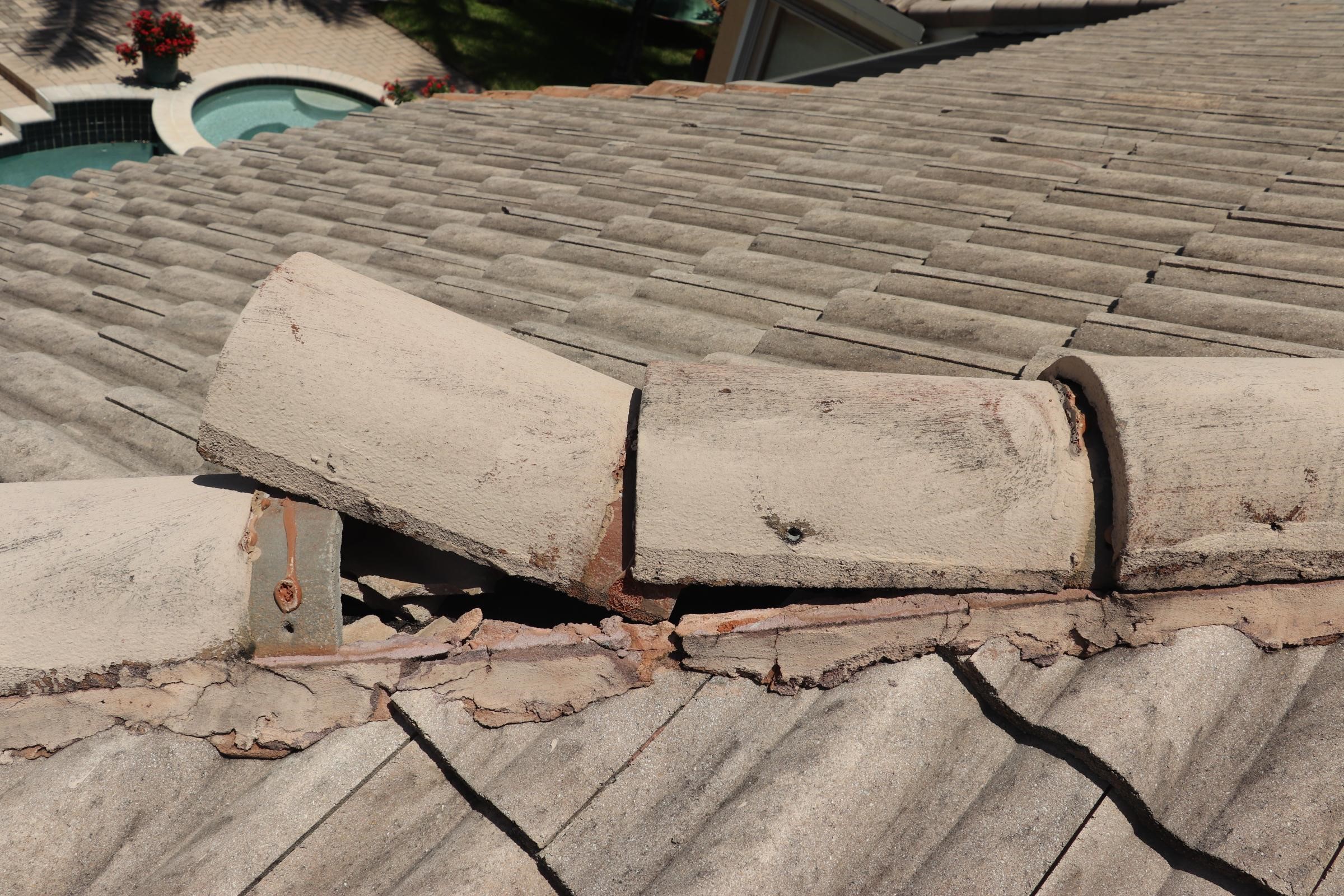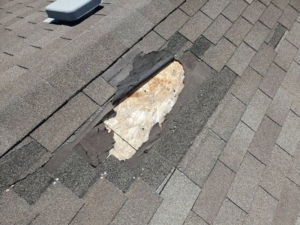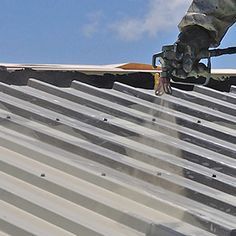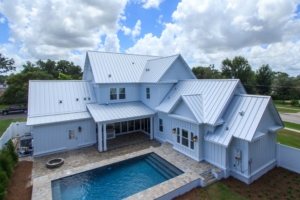Everything You Need to Know
About Concrete Tile Roofs
Concrete tile roofs are an excellent choice for homeowners seeking durability and longevity in their roofing materials. With their distinctive appearance and ability to withstand harsh weather conditions, concrete tile roofs offer both aesthetic appeal and practicality. In this blog post, we will explore the benefits of concrete tile roofs, including their long lifespan, energy efficiency, and low maintenance requirements. Whether you are considering a new roof installation or looking to replace your existing roof, understanding the advantages of concrete tile roofs will help you make an informed decision for your home. Read on to discover why concrete tile roofs are a smart investment for any homeowner.
What is a Concrete Tile Roof?
A concrete tile roof, also known as a cement tile roof, is a type of roofing material made from a mixture of cement, sand, and water. These tiles are designed to resemble traditional clay or slate tiles but offer several advantages over their counterparts.
Definition of Concrete Tile Roof
Concrete tiles are produced by pouring a mixture of cement, sand, and water into molds. The mixture is then left to cure, resulting in durable and sturdy tiles with a unique appearance. These tiles come in various shapes, sizes, and colors, allowing homeowners to choose the style that best suits their aesthetic preferences.
Advantages of Concrete Tile Roof
- Durability: Concrete tiles are highly durable and can withstand harsh weather conditions, including heavy rain, hail, and wind. They have a long lifespan, often lasting 50 years or more with proper maintenance.
- Fire Resistance: Concrete tiles are non-combustible, making them an excellent choice for fire-prone areas. They provide an added layer of protection to your home, reducing the risk of fire damage.
- Energy Efficiency: Concrete tiles have excellent thermal properties, helping to insulate your home and reduce energy consumption. They can keep your home cooler in hot climates and retain heat during colder seasons, leading to potential energy savings.
- Low Maintenance: Unlike some other roofing materials, concrete tiles require minimal maintenance. They are resistant to rot, insects, and mildew. Regular inspections and cleaning are typically sufficient to keep the roof in good condition.
- Variety of Styles: Concrete tiles offer a wide range of styles and colors, allowing homeowners to achieve the desired look for their homes. Whether you prefer a classic, modern, or Mediterranean style, there’s a concrete tile option to suit your taste.
- Cost-Effective: While the upfront cost of installing a concrete tile roof may be higher compared to other materials, its long lifespan and low maintenance requirements make it a cost-effective choice in the long run. Additionally, its energy-efficient properties can contribute to potential savings on heating and cooling expenses.
Types of Concrete Tile Roof
Concrete tile roofs are a durable and aesthetically pleasing roofing option that can enhance the overall look of your home. There are different types of concrete tile roofs to choose from, each with its own unique characteristics. In this section, we will explore three popular types of concrete tile roofs: Flat Concrete Tile Roof, Low Profile Concrete Tile Roof, and High Profile Concrete Tile Roof.
Flat Concrete Tile Roof
Flat concrete tile roofs are known for their versatility and sleek appearance. They have a modern and minimalist design that complements contemporary style homes. These tiles are typically rectangular or square in shape and lay flat on the roof. Flat concrete tile roofs provide a clean and streamlined look, adding a touch of elegance to any architectural design.
One of the key advantages of flat concrete tile roofs is their ease of installation. They are lightweight and can be installed quickly, saving both time and money. Additionally, these tiles come in a wide range of colors and finishes, allowing homeowners to customize their roof to suit their preferences.
Low Profile Concrete Tile Roof
Low profile concrete tile roofs offer a blend of functionality and aesthetics. These tiles have a slightly curved shape, which gives them a more dimensional appearance compared to flat tiles. The gentle curve creates a subtle shadowing effect on the roof surface, adding depth and visual interest.
One of the main benefits of low profile concrete tile roofs is their superior water resistance. The curved design helps to channel water away from the roof, reducing the risk of leaks and water damage. This makes them an excellent choice for areas with heavy rainfall or frequent storms.
High Profile Concrete Tile Roof
High profile concrete tile roofs are known for their bold and striking appearance. These tiles have a more pronounced curve, giving them a distinctive high-profile silhouette. They add a touch of grandeur and elegance to homes with traditional or Mediterranean architectural styles.
The enhanced curvature of high profile concrete tile roofs allows for excellent water drainage. The deep channels between the tiles help to efficiently direct water away from the roof, preventing water pooling and potential damage. In addition to their functionality, high profile concrete tile roofs create a visually captivating roofline that can greatly enhance the overall curb appeal of a property.
Benefits of a Concrete Tile Roof
Concrete tile roofs offer numerous benefits that make them a popular choice for homeowners. From exceptional durability and longevity to energy efficiency and fire resistance, there are several reasons why a concrete tile roof can be a wise investment for your home.
Durability and Longevity
One of the key advantages of a concrete tile roof is its exceptional durability. Concrete is a sturdy material that can withstand different weather conditions, including high winds, hail, and heavy rain. Unlike other roofing materials that may deteriorate over time, concrete tiles are built to last.
In fact, concrete tile roofs have an impressive lifespan and can easily exceed 50 years with proper maintenance. This longevity ensures that your roof will remain durable and intact, providing reliable protection for your home for decades to come.
Energy Efficiency
Concrete tile roofs are known for their energy-efficient properties. The thermal mass of concrete tiles helps to regulate temperature fluctuations, keeping your home cooler in the summer and warmer in the winter. This can significantly reduce your reliance on heating and cooling systems, leading to potential energy savings and lower utility bills.
Additionally, some concrete tile roofs are designed with reflective coatings that can further enhance energy efficiency by minimizing heat absorption. This feature can be particularly beneficial in regions with hot climates, helping to keep your home comfortable while reducing the strain on your HVAC system.
Fire Resistance
When it comes to safeguarding your home against fire hazards, a concrete tile roof can offer invaluable peace of mind. Concrete tiles have excellent fire-resistant properties, making them less susceptible to ignition from external sources such as sparks or embers.
Unlike flammable roofing materials like wood shingles or asphalt, concrete tiles can help to prevent the spread of fire. Their inherent resistance to flames and heat can provide an additional layer of protection, giving you and your family precious time to evacuate or for emergency responders to arrive.
Low Maintenance
Another advantage of concrete tile roofs is their low maintenance requirements. Once installed, these roofs generally require minimal upkeep, saving you time and money in the long run. Concrete tiles are resistant to rot, insects, and weather-related damage, reducing the need for frequent repairs or replacements.
Routine inspections and occasional cleaning to remove debris are typically all that’s needed to keep a concrete tile roof in good condition. This low maintenance aspect makes concrete tile roofs an attractive choice for homeowners seeking durable, hassle-free roofing solutions.
Installation Process of Concrete Tile Roof
The installation process of a concrete tile roof involves several stages to ensure a durable and aesthetically pleasing result. Proper pre-installation preparation, laying the concrete tiles, and securing and finishing the roof are essential steps in achieving a successful installation. Let’s delve into each of these stages in detail.
Pre-Installation Preparation
Before laying the concrete tiles, thorough pre-installation preparation is needed. This stage sets the foundation for a smooth installation process. Here are the key steps involved:
- Inspection and Planning: A professional roofing contractor will inspect the existing roof structure, ensuring it is in good condition to support the additional weight of the concrete tiles. Proper planning, including measuring the roof’s dimensions and determining tile layout, is vital for an efficient installation.
- Surface Preparation: The roof surface needs to be cleaned of any debris, dirt, or moss. This helps in ensuring a clean and even surface for laying the concrete tiles. Any repairs, such as fixing damaged sheathing or replacing worn-out underlayment, should be addressed at this stage.
- Underlayment Installation: A high-quality underlayment, such as synthetic or asphalt-saturated felt, is installed over the roof surface. This acts as a secondary barrier against water penetration and provides additional protection.
- Flashing and Ventilation: Proper flashing and ventilation systems are done for a watertight, well-ventilated roof. Flashing is used to seal vulnerable areas such as chimneys, skylights, and roof junctions. Adequate ventilation helps in reducing heat buildup and preventing moisture-related issues.
Laying the Concrete Tiles
Once the pre-installation preparation is complete, the next step is to lay the concrete tiles. This is a meticulous process that requires attention to detail and precision. Here’s what it entails:
- Tile Layout: The roofing contractor will determine the layout pattern based on the specific design and architectural requirements. The tiles should be arranged in a way that ensures proper water drainage and enhances the overall aesthetics of the roof.
- Installation: Each concrete tile is carefully placed onto the roof, interlocking with adjacent tiles. The tiles are aligned and leveled to create a uniform appearance. It’s important to follow the manufacturer’s guidelines for the correct installation technique.
- Cutting and Trimming: In order to achieve a seamless fit around roof edges, valleys, and protrusions, some tiles may require cutting and trimming. This is done with precision tools to ensure accurate sizing and a professional finish.
Securing and Finishing the Roof
The final stage of the concrete tile roof installation involves securing the tiles and adding finishing touches. This step ensures the roof is protected and visually appealing. Consider the following aspects:
- Fastening: The concrete tiles are securely fastened to the roof structure using nails or screws. The exact method may vary depending on the tile design and manufacturer’s recommendations. Properly fastening the tiles is essential to withstand high winds and prevent dislodgment.
- Ridge and Hip Installation: Ridge and hip tiles are installed along the roof peaks and edges. This enhances the roof’s structural integrity and provides an attractive finish.
- Waterproofing and Sealing: To ensure maximum protection against water infiltration, the roof is carefully waterproofed, paying attention to vulnerable areas like valleys and intersections. Sealants or other waterproofing materials are applied to reinforce the roof’s resistance to leaks.
- Final Inspection: Once the installation is complete, a thorough inspection is conducted to ensure the roof meets all quality standards. Any necessary adjustments or touch-ups are made before declaring the installation complete.
The installation process of a concrete tile roof demands expertise, precision, and attention to detail. By following these steps diligently, you can achieve a durable, long-lasting roof that adds beauty and value to your property.
Cost of Concrete Tile Roof
If you’re considering a concrete tile roof for your home, one important aspect to factor into your decision-making process is the cost. Understanding the cost of a concrete tile roof can help you determine if it fits within your budget and provides a worthwhile investment for your property. In this section, we will explore the factors that influence the cost of a concrete tile roof, compare it with other roofing materials, and discuss its return on investment.
Factors Affecting the Cost
Several factors come into play when determining the cost of a concrete tile roof:
- Roof Size and Complexity: The size and complexity of your roof will impact the total cost. Larger roofs require more materials and labor, thus increasing the overall expense. Additionally, roofs with multiple angles, hips, or valleys may require additional time and expertise, affecting the cost.
- Tile Quality and Design: The quality and design of the concrete tiles you choose can significantly influence the overall cost. Higher-quality tiles may be more expensive but offer enhanced durability and aesthetic appeal. Intricate designs or custom colors may also contribute to a higher price tag.
- Installation Considerations: The installation process of concrete tile roofs can be more labor-intensive compared to other roofing materials. Factors such as the need for structural reinforcement, underlayment requirements, and the complexity of the installation can impact the cost.
- Geographical Location: The cost of labor and materials varies by region. Factors such as local building codes and regulations, availability of skilled labor, and transportation costs can vary from one area to another, affecting the overall cost of the roof.
Comparison with Other Roofing Materials
When considering the cost of a concrete tile roof, it’s essential to compare it with other roofing materials to make an informed decision:
- Asphalt Shingles: Concrete tile roofs generally have a higher upfront cost than asphalt shingle roofs. However, concrete tiles offer superior durability and longevity, which can offset the initial investment over the long term.
- Metal Roofing: Metal roofs can be more expensive than concrete tile roofs, depending on the specific type of metal used. While metal roofs offer excellent durability and energy efficiency, their higher price may not fit every budget.
- Wood Shakes: Concrete tile roofs typically have a similar or slightly higher cost than wood shake roofs. However, concrete tiles offer better resistance to fire, rot, and pests, making them a more practical long-term investment.
Return on Investment
Investing in a concrete tile roof can provide a solid return on investment over time:
- Durability and Longevity: Concrete tile roofs are known for their exceptional durability, with a lifespan of 50 years or more. This longevity translates into potential savings on future repairs and replacements compared to other roofing materials.
- Increased Property Value: A concrete tile roof can enhance the curb appeal and value of your home. Its aesthetic appeal and reputation for durability can make your property more attractive to potential buyers, potentially increasing its resale value.
- Energy Efficiency: Concrete tiles have excellent thermal properties, helping to insulate your home and reduce energy consumption. This can result in lower heating and cooling costs, providing long-term savings and a positive impact on your overall return on investment.
Maintenance and Repair of Concrete Tile Roof
Concrete tile roofs are a popular choice for homeowners due to their durability and aesthetic appeal. However, like any other roofing material, concrete tile roofs require regular maintenance and occasional repairs to ensure their longevity and performance. In this section, we will discuss the importance of regular inspections and cleaning, as well as common issues that may arise and how to address them effectively.
Regular Inspections and Cleaning
Regular inspections are needed to identify and address potential issues with your concrete tile roof before they escalate into major problems. It is recommended to inspect your roof at least once or twice a year, preferably during spring and fall. During the inspection, pay attention to the following areas:
- Tiles: Check for any broken, cracked, or loose tiles. These should be replaced promptly to prevent further damage.
- Flashing: Inspect the flashing around chimneys, vents, and skylights for signs of deterioration or damage. Damaged flashing can lead to leaks, so repairs should be made as soon as possible.
- Gutters and Downspouts: Ensure that gutters and downspouts are clear of debris to prevent water backup and potential roof leaks. Regular cleaning of gutters is essential for proper drainage.
- Moss and Algae: Look out for the growth of moss, algae, or other organic matter on the roof surface. These can retain moisture and cause tiles to deteriorate. Use a gentle cleaning solution or hire a professional for safe removal.
Common Issues and Repairs
Despite their durability, concrete tile roofs can still encounter certain issues over time. Here are some common problems and recommended repairs:
- Cracked or Broken Tiles: Cracked or broken tiles should be replaced promptly to maintain the integrity of your roof. Remove the damaged tile carefully and install a new one in its place, ensuring proper alignment and secure fastening.
- Leaks: If you notice water stains on your ceilings or walls, it may indicate a leak in your concrete tile roof. Inspect the tiles around the affected area for cracks or damage. Repair or replace any damaged tiles and consider applying a waterproof sealant as an extra layer of protection.
- Buildup of Debris: Leaves, branches, and other debris can accumulate on the roof surface and in the gutters, causing drainage issues and potential damage. Regularly clean your roof and gutters to prevent debris buildup and ensure proper water flow.
- Loose or Damaged Flashing: Loose or damaged flashing can lead to water penetration and subsequent leaks. Replace or repair any faulty flashing to maintain a watertight seal around chimneys, vents, and other roof protrusions.
Remember, when it comes to maintenance and repairs for your concrete tile roof, it’s always best to consult with a professional roofer. They have the expertise and tools to handle any roofing issues effectively and safely.
Overall, regular inspections, cleaning, and timely repairs are needed to preserve the beauty and functionality of your concrete tile roof. By staying proactive and addressing any issues promptly, you can extend the lifespan of your roof and enjoy its benefits for years to come.
Conclusion
In conclusion, a concrete tile roof is a durable and long-lasting option for homeowners. With its ability to withstand extreme weather conditions, provide excellent insulation, and enhance the overall appearance of a property, it is a popular choice for many. Additionally, its low maintenance requirements and fire resistance make it an attractive option for those seeking peace of mind. When properly installed and maintained, a concrete tile roof can provide decades of protection and beauty for any home. So, if you are looking for a roofing solution that offers both functionality and aesthetic appeal, consider investing in a concrete tile roof.








